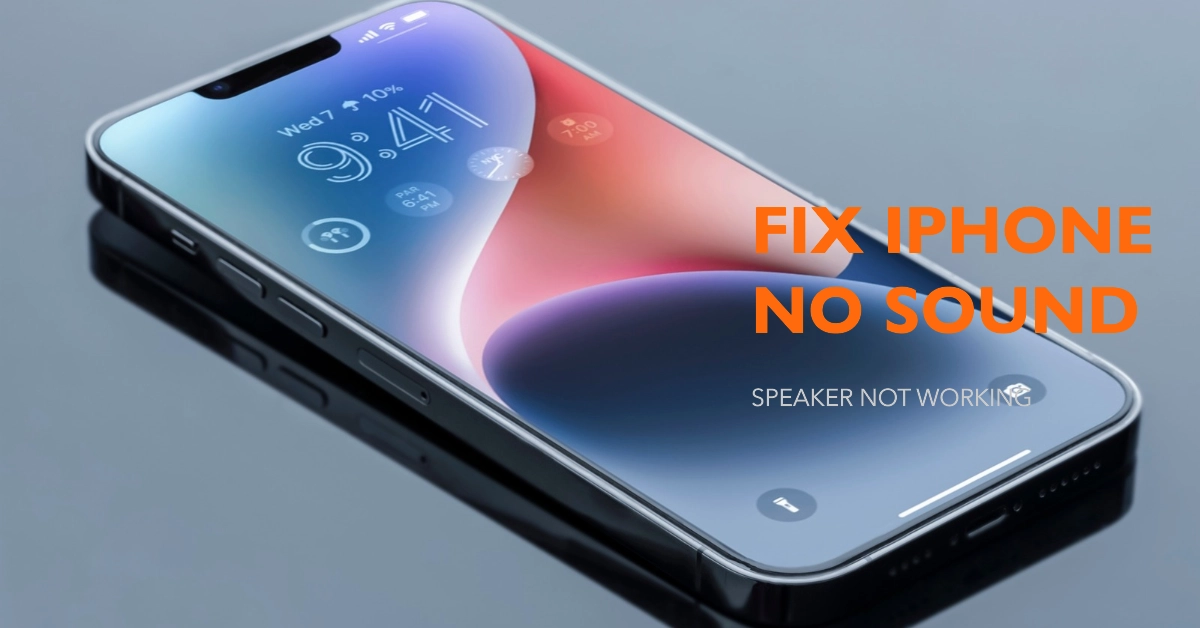Experiencing no sound or malfunctioning speakers on your iPhone can be frustrating. It disrupts calls, music, videos, and the overall enjoyment of your device. Don’t worry; several potential culprits can cause this problem.
This troubleshooting guide will take you through the most common solutions to help you restore your iPhone’s sound.
Problem Overview
Whether your iPhone speaker is completely silent or the sound is distorted, several potential causes could be at play. Before getting worried, let’s explore a range of solutions.
The issue could be as simple as a software setting or might require slightly more involved hardware troubleshooting. This article will systematically guide you through steps to diagnose and fix the problem.
Step-by-Step Troubleshooting
1. Basic Checks
- Check for Silent Mode: The Ring/Silent switch on the side of your iPhone is a common cause of unexpected silence. Make sure it’s toggled forward (towards the screen) so that the orange indicator isn’t visible.
- Verify Volume Levels: Go to Settings > Sounds & Haptics. Ensure the “Ringer and Alerts” slider is set to an audible level.
- Test with Headphones: Plug in headphones to see if you hear sound. If you do, the issue is likely with your iPhone’s built-in speakers.
2. Software Settings
- Do Not Disturb: Disable Do Not Disturb mode. Go to Settings > Focus > Do Not Disturb and toggle it off. Alternatively, open Control Center (swipe down from the top-right corner) and ensure the moon icon isn’t highlighted.
- Bluetooth: Bluetooth can sometimes cause audio to route to a paired device. Go to Settings > Bluetooth and disable it or disconnect any paired devices.
- Sound Output: When on a call, ensure the audio output is set to your iPhone speaker. Tap the speaker icon during a call to cycle audio outputs.
3. Cleaning the Speaker and Receiver
- Inspect for Debris: Lint or dust can accumulate in the speaker grille and receiver at the top of your iPhone. Examine these openings carefully.
- Cleaning: Use a soft-bristled brush (a dry toothbrush works well) to gently clean any visible debris. Avoid using liquids or compressed air, as they can damage the components.
4. Software Updates and Restart
- Check for Updates: Software glitches can sometimes cause audio issues. Go to Settings > General > Software Update and install any available updates.
- Restart your iPhone: A simple restart is often surprisingly effective. Press and hold the side button and a volume button until the “Slide to Power Off” appears. After powering off, restart your device.
5. Resetting Settings
- Reset All Settings: This won’t delete your data, but it will revert settings to their defaults, potentially clearing up any settings conflicts. Go to Settings > General > Transfer or Reset iPhone > Reset > Reset All Settings.
6. Advanced Troubleshooting
- Water Damage: If you had a recent liquid spill, water damage might be the issue. Power off your iPhone immediately and let it dry thoroughly. Consider seeking professional repair services for water damage assessment.
- Hardware Issues: If all other solutions fail, your iPhone might have a hardware problem with the speakers. Contact Apple Support or visit an authorized repair center for further diagnosis and repair options.
By following these steps, most iPhone speaker issues can be resolved without needing professional help. But if the problem persists after trying all these solutions, getting your device checked by an authorized Apple technician is recommended.
FAQs
1. Q: My iPhone speaker works for calls but not for music or videos. What’s wrong? A: This likely indicates a software problem. Check your volume settings in apps like Music or YouTube. Also, ensure that silent mode or Do Not Disturb aren’t accidentally enabled. If the problem persists, try restarting your device or resetting all settings.
2. Q: I’ve tried everything, and my iPhone speaker still doesn’t work. Could it be a hardware issue? A: Yes, if you’ve exhausted software solutions, it’s possible the speaker itself is damaged or faulty. This could be due to wear and tear, liquid damage, or a manufacturing defect. Contact Apple Support or an authorized repair center for diagnosis and repair options.
3. Q: Can dirt or dust block my iPhone speaker? A: Absolutely! The speaker and receiver grilles can accumulate dust or lint over time. This can muffle the sound or block it completely. Use a soft-bristled brush to gently clean the openings, but be very careful not to damage the delicate components.
4. Q: Will updating iOS fix my speaker problems? A: It’s possible! Software updates often include bug fixes and patches that address glitches with audio and other functions. Always keep your iPhone updated with the latest iOS version for optimal performance.
5. Q: Could a third-party app be causing my speaker problems? A: In some cases, yes. Recently installed apps might have conflicting settings or interfere with audio output. Try uninstalling any apps you installed just before the problem started. If that doesn’t work, resetting all settings can provide a clean slate.

